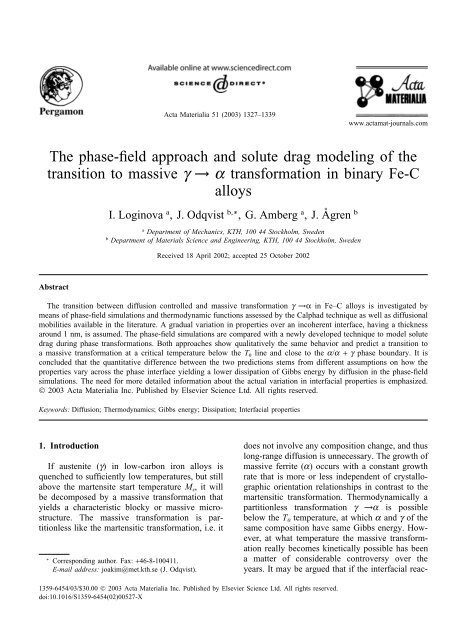Phase-field modeling of diffusion controlled phase ... - KTH Mechanics
Phase-field modeling of diffusion controlled phase ... - KTH Mechanics
Phase-field modeling of diffusion controlled phase ... - KTH Mechanics
You also want an ePaper? Increase the reach of your titles
YUMPU automatically turns print PDFs into web optimized ePapers that Google loves.
Acta Materialia 51 (2003) 1327–1339www.actamat-journals.comThe <strong>phase</strong>-<strong>field</strong> approach and solute drag <strong>modeling</strong> <strong>of</strong> thetransition to massive g → a transformation in binary Fe-CalloysI. Loginova a , J. Odqvist b,∗ , G. Amberg a ,J.Ågren baDepartment <strong>of</strong> <strong>Mechanics</strong>, <strong>KTH</strong>, 100 44 Stockholm, SwedenbDepartment <strong>of</strong> Materials Science and Engineering, <strong>KTH</strong>, 100 44 Stockholm, SwedenReceived 18 April 2002; accepted 25 October 2002AbstractThe transition between <strong>diffusion</strong> <strong>controlled</strong> and massive transformation g →α in Fe–C alloys is investigated bymeans <strong>of</strong> <strong>phase</strong>-<strong>field</strong> simulations and thermodynamic functions assessed by the Calphad technique as well as <strong>diffusion</strong>almobilities available in the literature. A gradual variation in properties over an incoherent interface, having a thicknessaround 1 nm, is assumed. The <strong>phase</strong>-<strong>field</strong> simulations are compared with a newly developed technique to model solutedrag during <strong>phase</strong> transformations. Both approaches show qualitatively the same behavior and predict a transition toa massive transformation at a critical temperature below the T 0 line and close to the a/a + g <strong>phase</strong> boundary. It isconcluded that the quantitative difference between the two predictions stems from different assumptions on how theproperties vary across the <strong>phase</strong> interface yielding a lower dissipation <strong>of</strong> Gibbs energy by <strong>diffusion</strong> in the <strong>phase</strong>-<strong>field</strong>simulations. The need for more detailed information about the actual variation in interfacial properties is emphasized.© 2003 Acta Materialia Inc. Published by Elsevier Science Ltd. All rights reserved.Keywords: Diffusion; Thermodynamics; Gibbs energy; Dissipation; Interfacial properties1. IntroductionIf austenite (g) in low-carbon iron alloys isquenched to sufficiently low temperatures, but stillabove the martensite start temperature M s , it willbe decomposed by a massive transformation thatyields a characteristic blocky or massive microstructure.The massive transformation is partitionlesslike the martensitic transformation, i.e. it∗Corresponding author. Fax: +46-8-100411.E-mail address: joakim@met.kth.se (J. Odqvist).does not involve any composition change, and thuslong-range <strong>diffusion</strong> is unnecessary. The growth <strong>of</strong>massive ferrite (a) occurs with a constant growthrate that is more or less independent <strong>of</strong> crystallographicorientation relationships in contrast to themartensitic transformation. Thermodynamically apartitionless transformation g →a is possiblebelow the T 0 temperature, at which a and g <strong>of</strong> thesame composition have same Gibbs energy. However,at what temperature the massive transformationreally becomes kinetically possible has beena matter <strong>of</strong> considerable controversy over theyears. It may be argued that if the interfacial reac-1359-6454/03/$30.00 © 2003 Acta Materialia Inc. Published by Elsevier Science Ltd. All rights reserved.doi:10.1016/S1359-6454(02)00527-X
















